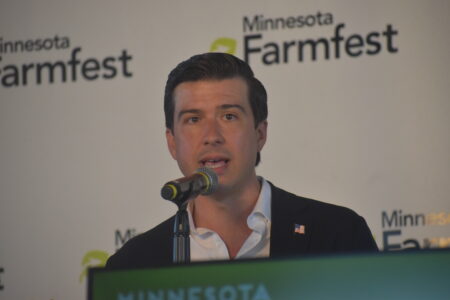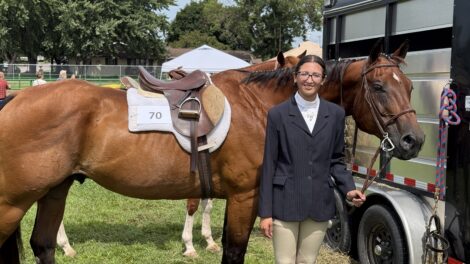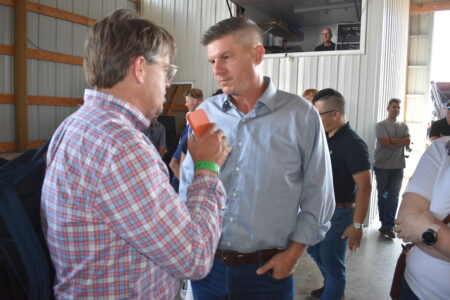Lunch and a Bite of History: Sveine talks about New Ulm’s grocery stores

Staff photo by Clay Schuldt Terry Sveine gave a summary of grocery store evolution in New Ulm on Thursday.
NEW ULM — Brown County Historical Society lunchtime history presentations continued Thursday with the history of grocery stores in New Ulm.
Terry Sveine gave a summary of grocery store evolution in New Ulm. Sveine said his presentation was not a listing of every grocery store from New Ulm’s past, but a summary of the changes in grocery stores and the reasons for them.
Grocery store history began in Brown County with the Little Rock Trading Post (1834-1856). This trading post was about 10 miles up the river toward Fort Ridgely. It was not a grocery store by modern standards. It sold many items, such as hunting gear, but it also sold groceries. This was a common thread with the first grocery stores.
“There was rarely a pure grocery store,” Sveine said. Stores selling groceries in the 1800s usually sold other items. None were defined by grocery sales.
By the late 1800s, stores began advertising grocery sales in the newspapers. Sveine pointed out the early ads featured no store address. New Ulm was small enough that a specific address was unnecessary. If a customer was looking for a specific store, they could easily find it. Many buildings had no street address because the post office did not make home delivery yet.
The first exclusive grocery store opened in New Ulm in the 1870s. It was called the “One-Horse Grocery Store”. The name was a reference to the delivery service offered by the store. The owner had only one horse.
Around the early 1900s, grocery stores began advertising with the word “pure”. Store owners made a point of stating their food was pure. Sveine believes this was in response to Upton Sinclair’s book “The Jungle” that exposed the Chicago meatpacking business for shady business dealings. The Food and Drug Act was passed in 1906.
“People had become super conscious that this was pure food groceries,” Sveine said.
The first street address began appearing in New Ulm grocery store ads in 1920 and it contained an error. The first street address was for a New Ulm grocery store on Main Street, but New Ulm did not have a Main Street.
The 1920s saw the growth of national brands and larger grocery businesses. In New Ulm, this led to the heyday of neighborhood grocery stores.
New Ulm grew in size during the early 1900s, but because the city was contained by two rivers, it grew to the north and south. The larger stores were located in the center of town. The smaller neighborhood grocery stores served citizens on the extreme ends of town.
The neighborhood grocery stores were more social experience. The owners were the clerks and would pull items off the shelf for the customers. Many customers visited every day and developed personal relationships with the grocers.
The invention of food preservation technology was the biggest change to grocery stores. Refrigeration and plastic containers meant people could buy more food at one time and store it at home.
An A&P Grocery store came to New Ulm in 1943. The store was self-service and had a larger selection. Since the store was self-service, all customers needed to reach the products. The aisle shelves shrunk in height in grocery stores, but the size of stores increased.
Jenkins grocery store came in 1953 and began advertising as a “Super Market”.
Sveine said these larger chain stores could offer larger promotions the little stores could not. These stores began cutting into ancillary food stores, like bakeries and butcher shops.
The 1960s saw a significant change in grocery store culture. Grocery shopping became something people needed to do and was less of a social occasion.
Before the 1960s most of the grocery shopping was done by women, but as women began entering the workforce the time for grocery shopping was reduced. People needed a one-stop shop for grocery stores.
Grocery store parking lots expanded to accommodate extra cars. No longer did working mothers walk to the market, they drove their cars to the store after work. These large parking lots required extra space and the grocery stores were pushed to the outer edge of New Ulm. This took much of the daily traffic away from downtown.
These larger stores were part of changes, meaning the people working at the grocery store did not own it, they only managed it. Social interactions at the store went away and the neighborly feeling was lost.
“Grocery shopping went from something you wanted to do to something you have to do,” Sveine said.
Despite the larger supermarkets driving smaller neighborhood stores out of business, Sveine argued that the neighborhood store technically still existed in convenient stores like Kwik Trip. These stores primarily sell gas, but they do have food departments.
Sveine closed his presentation saying the quaintness of past grocery shopping experience is gone and unlikely to come back. However, the younger generation is unaware of the old ways of shopping and does not miss it.
He argued returning to the good old days is not something we wanted.
“The reason these things exist is that we support them,” Sveine said. “We might not have many other choices, but we buy into it.”
The next Lunch and a Bite of History event are scheduled for noon Thursday, June 3, and will feature author Patrick L. Shannon, writer of “Minnesota Headline Murders! 1900-1919”. He will speak about his true crime book.
COVID-19 limits capacity. Those wishing to attend are encouraged to sign-up in advance.





